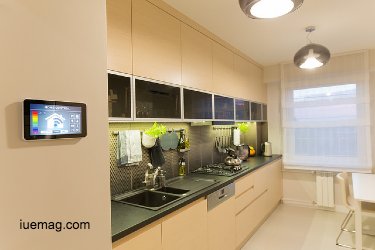

Latest Inspiring Trends in Smart Home Design

Image Credits: Lendi
The annual growth rate of the smart home industry is staggering, currently sitting at 31%. With 16.3% of homes falling under the ‘smart’ bracket, this figure is only expected to increase in the coming years. Starting to feel the FOMO and thinking of joining the smart home bandwagon? Here are the latest trends you should be aware of.
Smart Products Galore
Smart products, from appliances to entertainment units, are now capable of helping pretty much every single aspect of your life:
Voice control your life.The ability to control your home using your voice has been around for a while, but Google Home and Amazon Echo have changed the game. They’re more accurate and tap into a wide range of services (e.g. Spotify, your lighting, Nest, Netflix, and more).
Water and air quality monitoring.Smart appliances are now not only able to measure the quality of the water and air in your home, but they are also able to send instant push notifications to your phone. This allows you to respond to dangers such as carbon monoxide, even when you’re away on vacation.
Health and sleep.Startups are particularly hot in this space, having introduced products such as sleep robots (literally robots you can sleep with and cuddle!) and alarm clocks that track your movement and heart rate to wake you up at the right time. You can also buy a smart bed, such as the Sleep Number 360 i10, which moves your bed as you sleep (tilting it based on your snoring during the night, for example!), changes the temperature in response to your body, and adjusts firmness for maximum comfort.
Smart security.The Amazon Cloud Cam is an awesome example of a smart security camera that can help you keep your home safe. It offers an HD live feed, sends push notifications based on unexpected movements, and has 24-hour clip storage so you can review what’s happening whilst you’re away.
All of these products are heavily reliant on having a functioning WiFi connection. Of course, you’re going to need plenty of juice when it comes to your bandwidth. Smart homes aren’t exactly light on internet usage, so make sure you do a little bit of broadband comparison shopping before signing up to a new provider.
Integrated Smart Kitchens
The millennial that is able to afford a home in the big city (and they’re few and far between!) generally deals with a very common problem: a lack of space. Bedrooms are the size of what baby boomers would call a walk-in closet, while kitchens are pokey and claustrophobic. The smart kitchen, however, goes a long way towards the issue using technology.
For example, one of the very cool features we’ve seen recently is the countertop that also doubles as a charger. Compatible appliances are wirelessly charged; all you have to do is put them down on the countertop. I’ll tell ya, it’s a weird sensation to chop carrots and onions on the same surface that charges an iPhone.
The smart kitchen is fully integrated, with big companies such as Bosch designing their appliances to work together as part of a whole, rather than individual pieces. This makes it much easier to have multifunctional appliances that use space effectively. Apps such as Bosch Home Connect allows users to monitor every single compatible appliance from their smartphone. The app allows users to reorder products for their appliances (think dishwasher tablets, coffee, etc.), monitor appliances with remote diagnostics, and use voice control services such as Alexa to set oven timers or change the cooking program.
Smart Home Deliveries
Isn’t it annoying when you’re expecting a package, but you’re out all day and can’t be there for the delivery? If you’re lucky, they’ve left it in one piece on your doorstep. But there are plenty of horror stories of stolen deliveries as well.With smart deliveries, you can forget about this problem. Walmart recently struck a partnership with August Home, which sells smart locks, to test what they term as “in-fridge deliveries”. Not home? No problem.
The company will not only deliver your products, but they’ll also put them away if they need to be refrigerated. Amazon Key works on a similar premise, allowing couriers to leave packages inside your home if you happen to be out.
Copyrights © 2025 Inspiration Unlimited - iU - Online Global Positivity Media
Any facts, figures or references stated here are made by the author & don't reflect the endorsement of iU at all times unless otherwise drafted by official staff at iU. A part [small/large] could be AI generated content at times and it's inevitable today. If you have a feedback particularly with regards to that, feel free to let us know. This article was first published here on 23rd January 2019.
Overthinking? Uninspired? Brain Fogged?
Let's Reset That! Try iU's Positivity Chat NOW!

All chats are end-to-end encrypted by WhatsApp and won't be shared anywhere [won't be stored either].


